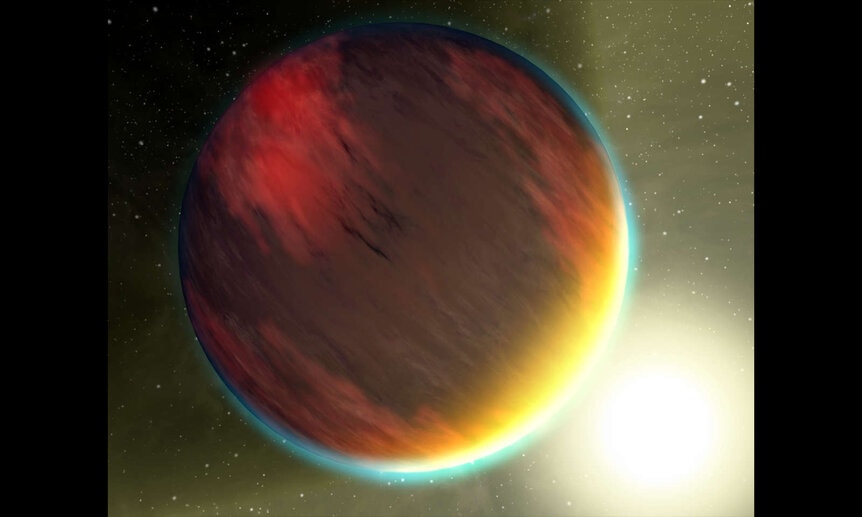Create a free profile to get unlimited access to exclusive videos, sweepstakes, and more!
WASP-76b is hot enough to ionize your bones

One of the most amazing things we’ve learned by discovering exoplanets — alien worlds orbiting other stars — is just how humdrum our own solar system is.
The very first planets confirmed orbited a pulsar, the animated corpse of a massive star that had exploded long ago in a supernova. The first planets found orbiting “normal” stars like the Sun were hot Jupiters: massive gas giants like our own, but orbiting so close to their host stars they’re hotter than Mercury.
Among those, WASP-76b a scorcher.
The planet was first announced in 2016 using the Wide Angle Search for Planets (WASP) observatories, multiple wide-angle cameras that look for tell-tale dips in starlight due to an orbiting planet periodically passing in front of the star.
WASP-76 is a star about 640 light years from Earth, and is 50% more massive than the Sun and 500°C hotter. The planet, WASP-76b, is 1.8 times wider than Jupiter but only about 90% its mass. This implies it’s puffed up, expanded due to the heat of its star.
Why? WASP-76b’s orbit is only 1.8 Earth days long, very short indeed, indicating it orbits the star only about 4 million kilometers above its surface.
Yikes. Even Mercury stays about ten times farther from the Sun that that. That’s why WASP-76b is called an ultra-hot Jupiter.
The planet orbits so close to the star that it’s likely tidally locked, meaning it spins once for every time it orbits, so its day and year are both 1.8 Earth days long. However, being a gas giant it doesn’t have a surface per se, but it’s likely the gas on the side facing the star heats up so much it expands and flows around to the planet’s night side. Models of the physics of the system indicate the temperature at the cloud tops is somewhere around 2,400°C (4,400°F)!
But hang tight; it gets better…
WASP-76b transits the star, which means from our point of view on Earth it passes directly in front of the star, making a mini-eclipse. Because it’s a gas giant, its atmosphere gets thinner with height, allowing some starlight to pass through.
Gas absorbs very specific colors of light that pass through it depending on the atoms and molecules in that gas, and what state they’re in (for example, they have all their electrons and are neutral, or have lost one or more electrons and are ionized). By carefully examining the light from WASP-76b during a transit, astronomers can determine the constituents of its atmosphere, even from 6.4 quadrillion kilometers away.
A lot of elements found were what we expect in such a situation: ionized lithium, sodium, magnesium, and more. Calcium was also seen, absorbing light in the violet part of the spectrum. A pair of absorption features, called the calcium H and K lines, have been seen before.
In new work, infrared observations show a strong detection of famous set of lines called the calcium triplet, light absorbed due to singly ionized calcium (i.e., it’s lost one electron). This is actually surprising, because you should only see these lines in gas that’s significantly hotter than predicted for WASP-76b using simple gas dynamics, or perhaps if the upper atmospheric winds are much stronger than expected. Interestingly, using models of the structure of the planet’s atmosphere, the astronomers find the absorption is happening from gas high enough up that it’s almost able to escape the planet due to the tides from the star itself. That would support the idea of strong winds blowing the calcium up that high.
Clearly, WASP-76b is not a place you want to visit. I’ll note that the one of the major ingredients in human bones is calcium. It vaporizes at about 1,500°C, and WASP-76b is so much hotter than that it’ll strip electrons off those vaporized atoms.
Heck, it’s possible that the atmosphere in WASP-76b s so hot it can vaporize iron, which condenses on the cooler night side and rains out. Yes, it may rain molten iron on WASP-76b! There is some controversy with this idea, because the atmosphere of the planet is a mess — the change in temperature is large from night to day, the winds fierce, and the rapid rotation mixing things up as well — and it’s possible the detection of iron in its air may be due to other sources instead.
But the point here is that telescopes and cameras are getting good enough to remotely (and metaphorically) sniff the air on planets hundreds of light years away, and astronomers can use that data to investigate conditions there.
Another point is also that some planets are really, really different than the ones we have in our own solar system. And WASP-76b isn’t even the hottest exoplanet known, not by a long shot.
It’s a weird Universe out there, and in many cases extraordinarily hostile to human life (ionized bones!). It also makes me wonder… we’ve discovered fewer than than 5,000 exoplanets so far in the past 25 years, probing a tiny fraction of the galaxy. There are 200 billion stars out there, and a decent fraction of these have planets orbiting them. What other amazing and bizarre planets will we find?

















